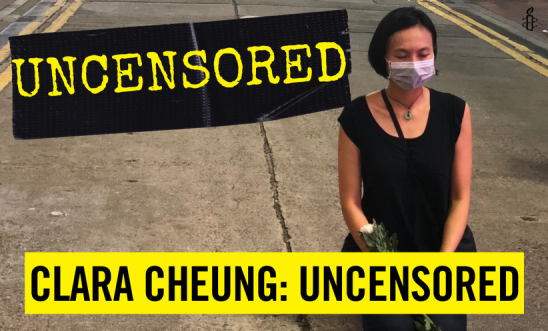
Clara Cheung: Uncensored

You can read the original Traditional Chinese version of this interview HERE.
Clara is an active member of the non-profit art group Project226, and the founder of C&G Artpartment.
From 2007 to 2021, she curated and co-curated more than 80 art exhibitions at C&G Artpartment, which situated in a “tong-lau” building apartment in Hong Kong. These exhibitions often critically responded to local social and cultural issues, including problems in the local art ecology.
She was a member of Wan Chai District Council from Jan 2020 to July 2021, attempting to contribute to the local political scene in Hong Kong with her creative problem-solving skills. She is currently based in the UK, as one of the Hongkongers in exile who persist fighting for the liberation of Hong Kong.
Besides continuing her artistic and curatorial practise, she is also a PhD candidate in the History of Art department at University of York.
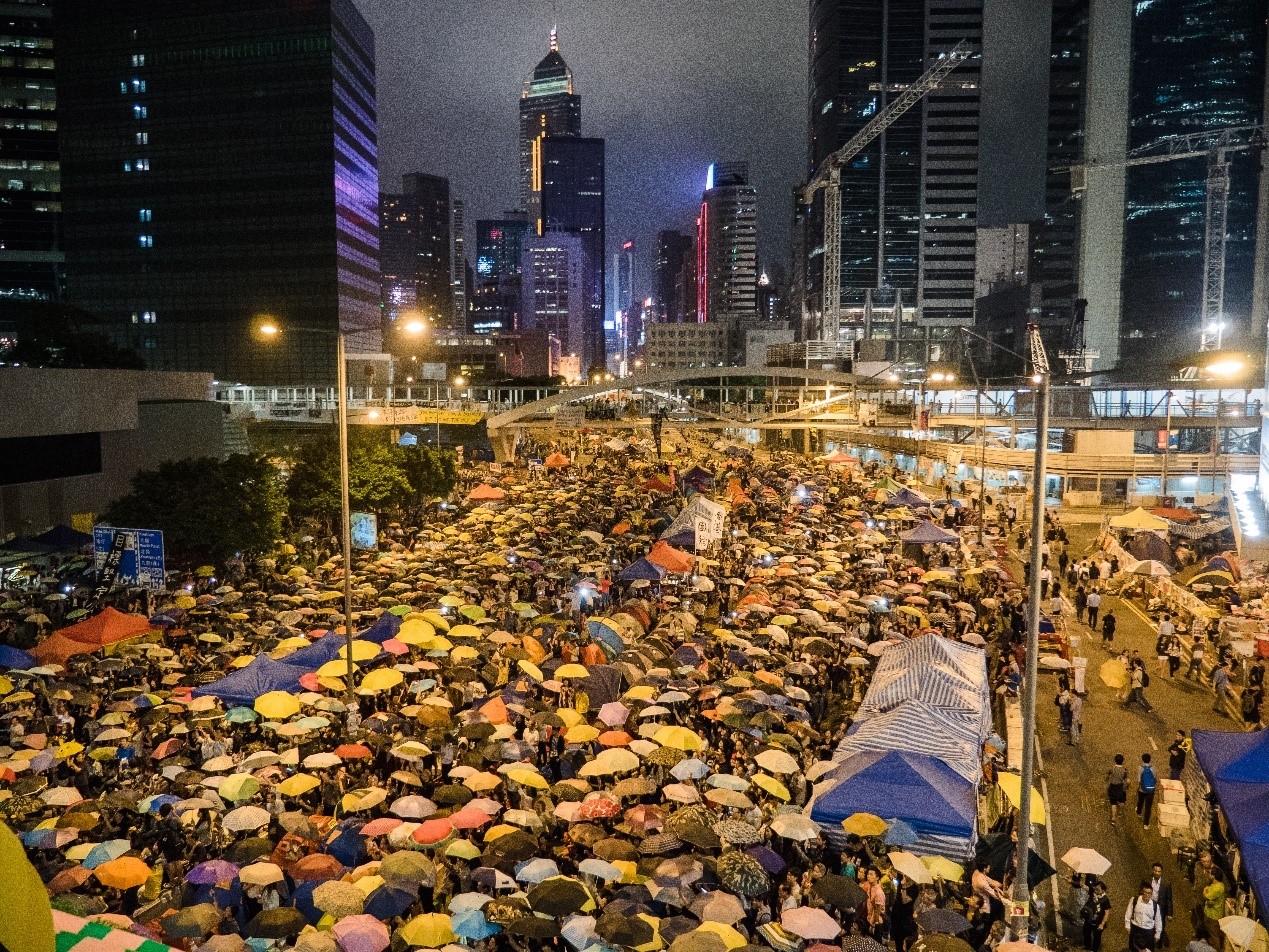 Harcourt Road in Hong Kong during the Umbrella Movement in 2014.
Harcourt Road in Hong Kong during the Umbrella Movement in 2014.
Translated Interview in English:
Curator Clara Cheung: Exploring Hong Kong issues as a UK-based artist. Blurred “red lines” and the loss of creative space
“There are two ‘Harcourt Roads’ on opposite sides of the globe - one in Hong Kong, the other in Sheffield.” In 2024, Hong Kong curator Clara Cheung and her husband, Gum, launched a unique research project in Sheffield, UK: 'Harcourt Roads in Parallel Worlds'.
Using 'Harcourt Road' as a theme, they explore the local Sheffield community to document the oral histories of residents and Hongkongers who have relocated to the UK. Through their stories, they hope to create a connection between Hong Kong and Britain.
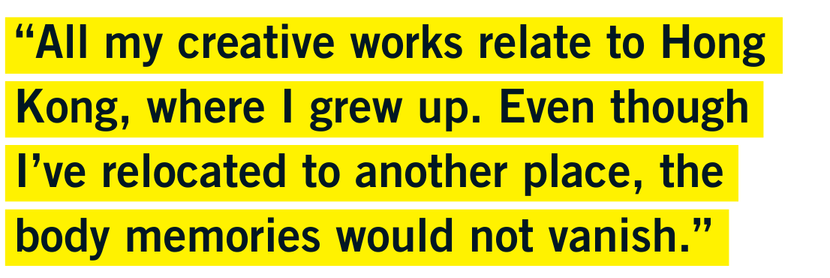
Founding an art space in response to social issues
Clara was introduced to contemporary art during her time at university and has since been devoted to artistic creation and curatorial work. In 2007, she and Gum co-founded the C&G Artpartment, aiming to provide Hong Kong artists with a space to respond to social issues through artistic language. “While studying in the US, I came across ‘institutional critique’, which involves critical reflection on existing systems.”
 C&G’s ‘Harcourt Roads in parallel World’. Clara is explaining the idea to residents in Sheffield. (Photo credit: Charles Lo)
C&G’s ‘Harcourt Roads in parallel World’. Clara is explaining the idea to residents in Sheffield. (Photo credit: Charles Lo)
Clara’s university years in the US coincided with Hong Kong handover to China in 1997, a topic that drew considerable international attention. She also began to reflect on Hongkongers’ cultural and political identities. “Many foreign media outlets were interested in how Hong Kong artists interpreted cultural identity,” she recalled. For Clara, this was a huge question that required an answer.
After 1997, international interest in the handover gradually declined, but the 'big question mark' remained. Clara noticed a lack of writing on Hong Kong’s art history and the city lacked fertile soil for nurturing fine art. This prompted her to find an art space to respond to social issues.

Clara recalled that before the demolition of the Star Ferry Pier in 2006, some artists engaged the public with on-site performance art. During the time when Donald Tsang was the Chief Executive, C&G Artpartment invited five artists to create a piece titled 'To Tsang, C.E.' to thank him for supporting the West Kowloon Cultural District project. “Our plan was to present it to Donald Tsang at a university graduation ceremony. He was ready to accept it, but the security intervened and blocked us.” She laughed. The interesting experience showed that the political atmosphere in Hong Kong at that time still had moments of levity.
The Umbrella Movement as a watershed
Clara said that when Patrick Ho served as the Secretary for Home Affairs from 2002 to 2007, he maintained a surface-level politeness towards activist artists. “Beijing didn’t launch a full-on crackdown overnight; it was a gradual process. But by 2014 (the year when the Umbrella Movement broke out), people clearly lost trust in each other.”
“Before 2014, when we carried out community-based art projects, we didn’t suspect people around us of working undercover for the Chinese Communist Party. But after 2014, people began to question the identities of those who seemed out of place.” she explained.
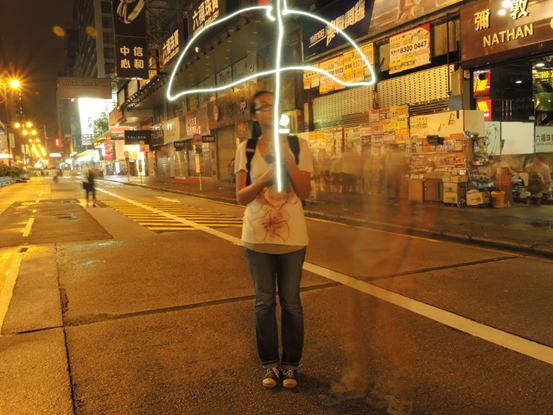
C&G Artpartment once organised an event called 'Beat it', where artists would perform and interact with the public in parks during the traditional day Jingzhe (Awakening of Insects) marking seasonal transition. During the exhibition, “there was a man in suit wearing an earpiece, who examined every exhibit meticulously,” Clara said although they should be happy for a member of public being so engaging, after the event they couldn’t help discuss if the authorities had been surveilling them.
Despite sensing a shift in the political atmosphere, Clara never gave up using art to respond to social issues. During the Umbrella Movement, she curated the 'Occupying Squatters' design competition in the government-funded Yau Ma Tei Woofer Ten,, where the public built their own “homes” using eco-friendly materials.
District Councils and “self-censorship”
Clara has never imposed limits on her own art or curatorial projects out of fear of unknowingly crossing the 'red lines'. However, it was during her time as a district councillor in Happy Valley that she felt the strongest sense of institutional self-censorship.
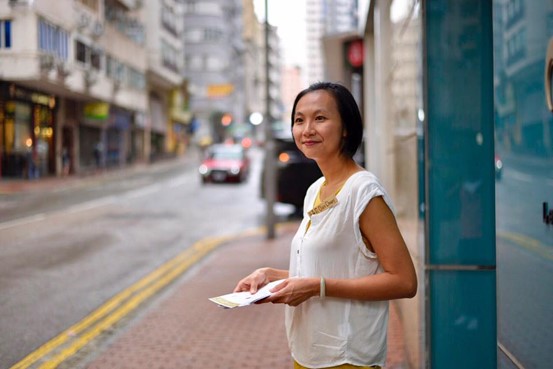
“In the first half of 2020, there was still space for discussion in some community projects. But after the enactment of the National Security Law in 2021, that space totally disappeared.” Clara pointed out that the Home Affairs Department would never outright declare a project illegal or forbidden, but the authority would use all sorts of administrative measures, such as budget issues, to put a stop to it.
As a district councillor, Clara had to balance the diverse political views of the residents in her district.

She felt that many civil servants genuinely wanted to do more for the public and were open to communication, but the authorities had systematically severed those dialogues.
“In 2021, even if you wrote relatively subtle slogans on the posters, it may not constitute a reason for arrest. For example, during Lunar New Year, I wrote ‘righteous people will be blessed’ (好人有好報) on fai chun (a traditional decoration for the festival). For some people, that was politically sensitive enough.” But later, even such euphemisms became off limits.
June Fourth commemoration on East Point Road: The last bastion of artistic freedom
To Clara, the last remaining bastion of artistic freedom in Hong Kong was the annual commemoration on East Point Road in Causeway Bay on the eve of 4 June. In 2021, she placed white flowers there as a form of performance art to commemorate the 1989 Tiananmen Square massacre.
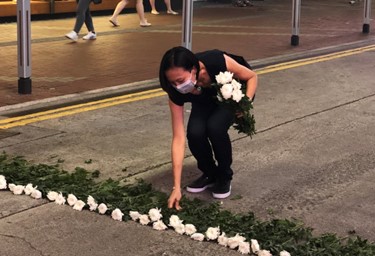
“Friends in the art industry still held that line. Sanmu Chen commemorated June Fourth almost every year with performance art. Last year, all he did was gesture the numbers ‘eight-nine-six-four’, and within seconds, police had surrounded and taken him away. That moment became a symbol of lost freedom.”
Clara believed the police officers’ physical response was the most telling 'lens' to capture that reality. She said, “In 2021, we all thought participating in June Fourth commemoration would only get you 48 hours of detention in the worst-case scenario. But now, our assessment is once you’re arrested, you can be sentenced to over two or three years in prison.”
Exploring Hong Kong issues as a UK-based artist
Having taken part in the 2020 pro-democracy primaries, which triggered massive arrests and years-long imprisonment, Clara came under political pressure. For safety reasons, she resigned as a district councillor in 2021 and emigrated to the UK with her family. In this new setting, she began re-examining Hongkongers’ cultural identity through her lens as an artist in exile, and has sought to do more advocacy work.
After settling in the UK, Clara curated an exhibition titled '24,901 Miles of Red Lines' which featured Hong Kong artworks no longer permitted, fellow members of the so-called 'Milk Tea Alliance', to take part. Looking ahead, Clara hopes to collaborate with more exiled Myanmar artists to explore issues of cultural identity in Southeast Asia. “When I first arrived, I met many Southeast Asian artists in the UK. They weren’t just concerned with racial discrimination but were also examining their own cultural roots. I participated in a project by a British-Hong Kong mixed artist, and it sparked many new ideas for me.”
 (Photo credit: Ayman Eckford)
(Photo credit: Ayman Eckford)
Clara added that art and culture can be a form of resistance for Hongkongers, rooted in core values that need to be upheld. Through diverse cultural and artistic activities, the diaspora can come together to discuss how to carry forward the spirit of resistance.
Last year Clara and Gum launched their Sheffield-based project, 'Harcourt Roads in Parallel Worlds.' “The inspiration came from a local resident who spent over ten years campaigning for a pedestrian crossing with traffic lights.” Through Sheffield’s history, she sees the possibility of grassroots, bottom-up reform to the system. “Although Hong Kong can’t achieve that for now, I still hope it might happen one day.”
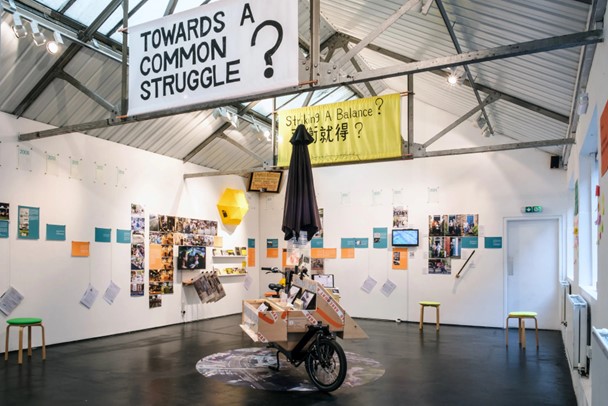 (Photo credit: James Clarkson)
(Photo credit: James Clarkson)
Original Interview in Traditional Chinese:
「紅線」模糊失去創作空間 策展人張嘉莉:以移英藝術家身份探索香港議題
「地球的兩端都有夏愨道,一條在香港,另一條在錫菲(Sheffield)。」2024年,香港策展人張嘉莉(Clara)和她的丈夫阿金,在英國錫菲啟動了一項特別的研究計劃——「平行世界的夏愨道」,以「夏愨道」為題材深入錫菲社區,記錄當地居民和移英港人的口述歷史,希望透過他們的故事將香港和英國連結起來。「我做的創作都跟香港有關,那是我成長的地方,即使已移民去另一個地方,身體記憶並不會消失。」Clara 說。
創辦藝術空間回應社會議題
Clara 自大學時期起已接觸當代藝術,之後一直從事藝術創作和策展工作,她和丈夫阿金於2007年創辦了 C&G藝術單位,希望給香港藝術家一個空間,用藝術語言回應香港的社會議題,「在美國讀大學的時候接觸到『體制批判』(institutional critique),會對現行體制作出批判性思考。」
Clara 在美國讀書的時候正值1997年香港回歸,國際相當關注這個議題,她亦開始思考香港人的文化身份與政治身份,「很多外國媒體會關注香港藝術家如何演繹香港的文化身份。」對她來說,這是一個很大的問號,需要尋找答案。
1997年之後,國際對香港回歸議題的關注度開始減退,但那個「大問號」仍然存在,Clara 發現坊間缺乏關於香港藝術歷史的文章,香港能提供純藝術創作的土壤亦不足,於是決定開創一個藝術空間,回應社會議題。「很多藝術家心中那團火仍未熄滅,是過往沒有空間讓大家去思考。」
Clara憶述2006年天星碼頭清拆前,有藝術家在現場以表演方式與公眾互動;曾蔭權擔任特首的年代,C&G藝術單位曾邀請五位藝術家,為曾蔭權創作了一個題為《致曾特首》的作品,感謝他對西九文娛藝術區項目的支持。「當時我們打算在一個大學畢業典禮上,將這份作品送給曾蔭權,他亦打算收下,只是被保安擋住了。」她笑言,那是一個有趣的經歷,香港的政治氣氛仍然有放鬆的時刻。
「雨傘運動」是一個分水嶺
Clara 直言,當年何志平擔任香港民政事務局局長,對維權藝術家仍然保持表面的禮貌,「北京當局不是一來就大開殺戒,而是循序漸進,直到2014年,很明顯地人與人之間失去信任。」
Clara 解釋:「2014年前落區做藝術項目,我們不會『捉鬼』,懷疑身邊的人是否中共派來的卧底,但2014年之後,大家看見相對奇怪的人,會開始討論他的身份。」
C&G藝術單位曾舉辦一個名為《打鑊金》的活動,在驚蟄前後的周末,會有藝術家在公園的公共空間進行展演,與民眾互動,「當時有個著西裝、穿戴耳機的男士,很仔細地看每一個展品。」Clara表示,有民眾參與藝術活動本應是高興的事,但活動過後大家都在討論是否有政權監察。
雖然感受到氣氛不對,Clara 從未放棄以藝術回應社會議題,即使在「雨傘運動」期間,她也參與油麻地活化廳所策展的「佔領小屋」設計比賽,讓民眾用環保物料搭建自己的「居所」。
區議會的「自我審查」
Clara 坦言,她在藝術創作和策展過程中,並未因為怕誤觸「紅線」而自我設限,反而在跑馬地擔任區議員期間,明顯感受到區議會的「自我審查」。
「2020年上半年,一些社區項目仍然有討論空間,到2021年《國安法》立法後,基本上連討論空間都沒有。」Clara指出,民政署不會明確地說這個社區項目違法或不能做,但會用各種行政手段,例如用「預算問題」等理由阻止項目進行。
因為區議員的身份,Clara需要平衡區內街坊的不同政見,她表示大家都不會在開會的時候表明政治立場,亦懂得「避重就輕」,她感受到很多公務員都希望為市民多做些事情,亦不抗拒跟市民溝通,但政權逐步封殺了與市民溝通的那道橋樑。
「2021年的時候,即使在海報上寫上一些較隱晦的標語,都未至於怕『要拉要鎖』,例如過年我會在揮春上寫『好人有好報』,其實可能對於某些家庭來說,已經相當敏感。」但去到後期,連這些較隱晦的文字也被禁止。
東角道「悼六四」是最後防線
對 Clara 來就,香港藝術自由的最後一道防線,是每年6月3日於銅鑼灣東角道的進行的「悼六四」活動,而她亦曾在2021年在東角道放置白花,用行為藝術悼念六四。
「藝術界的朋友仍然堅守那道防線,陳式森(三木)幾乎每年都以行為藝術紀念六四,去年只是比劃『八九六四』,數十秒後警員馬上包圍、把他帶走,那是一個(失去自由的)指標。」Clara 認為,當時警員的身體行動是最佳的「鏡頭」紀錄,她坦言,2021年參與「悼六四」活動,大家都認為最壞的情況是「監禁48小時」,但今時今日已經有所不同。「現時我們的判斷是,一旦被捕會被判監超過兩、三年。」
以移英藝術家身份探索香港議題
因為曾參與民主派初選,Clara 感受到政治壓力,基於安全考量,她在2021年辭去區議員職務,與家人一同移民英國。身處異地,她能夠以移英藝術家身份重新思索港人的文化身份議題,並嘗試在英國做更多倡議工作。
移居英國後,Clara 曾在英國策劃藝術展《24901哩紅線》,展出不能再在香港公開展示的香港藝術作品,更邀請緬甸和泰國兩個「奶茶聯盟」的藝術家參展。她日後亦希望連結更多緬甸流亡藝術家,一同探討東南亞的文化身份議題。「初到埗認識到很多居英的東南亞藝術家,他們除了探討種族歧視的議題,亦在探索東南亞的文化身份議題,我曾以新移民身份參與其中一個半英國半香港裔藝術家的展覽項目,帶給我很多新的想法。」
Clara又指,香港人可以通過藝術文化作為一種抗爭方式,而背後需要擁護香港的核心文化價值,透過不同面向的藝術文化活動,可以將離散港人凝聚起來,討論如何延續抗爭精神。
最近,Clara和阿金亦在錫菲啟動了一項研究計劃——「平行世界的夏愨道」,「靈感來自一個街坊,用十年以上的時間去爭取一個過路處的紅綠燈。」她在錫菲的歷史中看見,即使漫漫長路,亦有機會「由下而上」地改變現行體制的可能性。「雖然香港暫時做不到,但期望有一日能夠發展下去。」